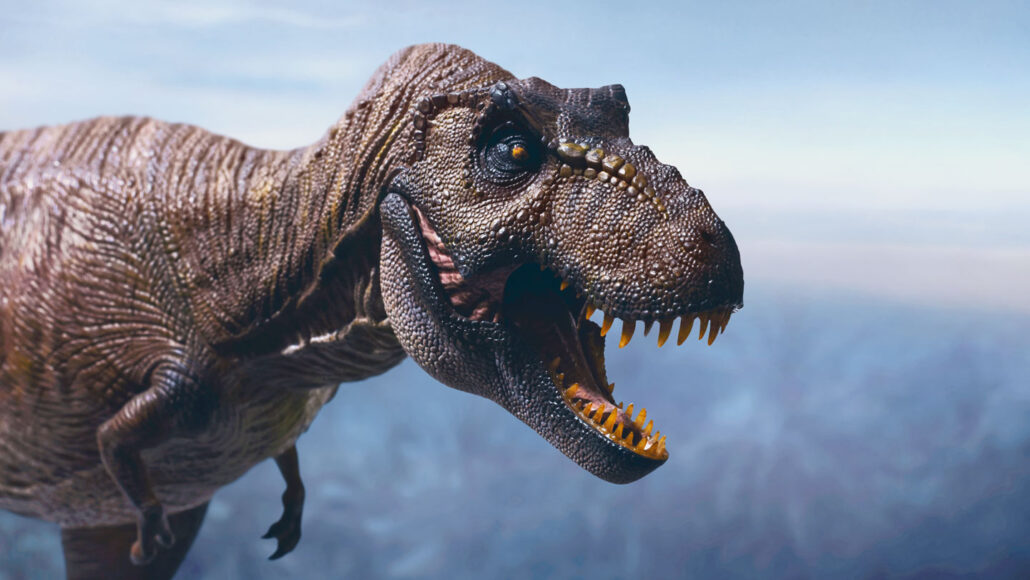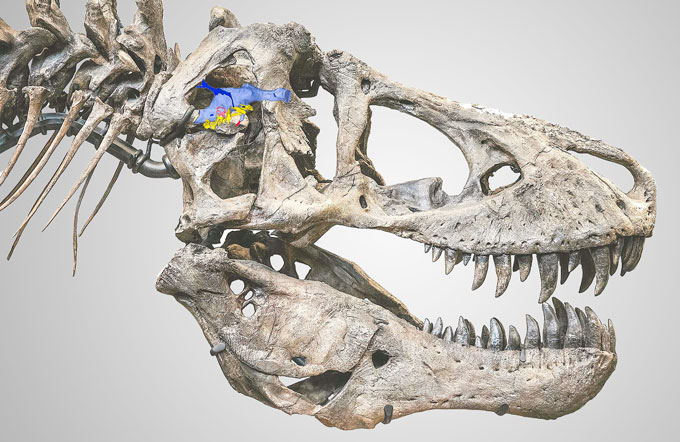Just how brainy was a T. rex?
Its brain had perhaps billions of neurons, but how the dino used them is still not clear

Scientists don’t agree on how to count brain cells in dinosaurs like Tyrannosaurus rex (illustrated). The debate is raising questions about how to understand extinct animals’ behavior.
FOTOKITA/istock/Getty Images Plus
By Freda Kreier
How brainy was Tyrannosaurus rex? It depends on who you ask.
Last year, the iconic dinosaur received the glow up of a lifetime. Neuroscientist Suzana Herculano-Houzel calculated that the fearsome reptile had 3.3 billion neurons — nerve cells — in just one part of the front of its brain. The discovery seemed to put the brainpower of T. rex’s forebrain on a par with that of modern baboons.
In fact, it suggested the ancient predator might have had the mental hardware to develop culture and make tools. But that claim raised some eyebrows — and doubts.
A new set of calculations has now spat out a much lower neuron count.
Dinos had closer to 360 million neurons in the telencephalon, this new study suggests. That part of the forebrain plays a role in sensing, thinking and coordinating motion. If true, this lower count would put T. rex on the mental level of crocodiles, not baboons. An international team of researchers shared the new count April 26 in The Anatomical Report.
Do you have a science question? We can help!
Submit your question here, and we might answer it an upcoming issue of Science News Explores
Those new calculations don’t convince Herculano-Houzel, who works at Vanderbilt University in Nashville, Tenn. There’s a “fatal mistake” here, that leads to the lower count, she says.
To calculate how many neurons an animal has, you must know how closely packed those brain cells were. And that can be tough because neuron density varies widely across animals. Also, brain cells aren’t well preserved in fossils. So when scientists study extinct animals, they must estimate neuron densities based on their modern relatives.
And here lies the issue: T. rex belongs to a group of dinosaurs known as theropods. It’s related to both reptiles and birds. But these two groups have vastly different neuron densities. Reptiles have fewer neurons per unit volume of brain than birds have. When calculating the number of neurons in extinct theropods like T. rex, researchers must decide whether to base their work on birds, reptiles or some mix of the two.
Bird-brained or reptile-headed
For her 2023 study, Herculano-Houzel worked out the relationship between brain size and body mass for some 30 different dinos. She then looked at how these numbers stacked up against modern birds and reptiles. Using ancient bird families hinted that theropod brains were more like bird brains. Thus, she used modern bird densities to do her calculations.
That assumption is flawed, even if birds are living dinosaurs, says Cristián Gutiérrez-Ibáñez. A comparative neuroscientist, he works at the University of Alberta in Edmonton, Canada. There, he studies the brains of different creatures. Birds vary in their ratio of brain size to body mass. So his team considered more birds that are alive today in their new study. That left T. rex’s brain-to-body ratio closer to that of scaly reptiles.
Herculano-Houzel’s study also inflated the numbers of neurons another way, Gutiérrez-Ibáñez says. She assumed that dinosaur brains occupied the whole braincase. As its name implies, this part of the skull houses the brain. But unlike modern birds, the brain of T. rex and many other dinosaurs floated in a fluid — much as do those in modern crocodiles.

Recalculating T. rex’s brain size based on filling less of the braincase slashed the neuron count, Gutiérrez-Ibáñez says. The estimate for the telencephalon dropped from 3.3 billion to 1.2 billion. Using reptile neuron density cut the amount even more: to between 245 million and 360 million.
Herculano-Houzel counters that her study indeed accounts for dinosaur brains not filling the braincase. What’s more, she argues, it doesn’t make sense to consider the body-brain ratios of a wide variety of modern birds. For her study, she considered only birds that are most closely related to dinosaurs. She says that by throwing in birds like pelicans and penguins — which have very different body-to-brain ratios — the new study incorrectly concluded that T. rex was like modern crocs.

Educators and Parents, Sign Up for The Cheat Sheet
Weekly updates to help you use Science News Explores in the learning environment
Thank you for signing up!
There was a problem signing you up.
Brains and behaviors
In any case, whether T. rex had a lot of neurons might not be a good gauge of the dinosaur’s overall brainpower, says Amy Balanoff at the Johns Hopkins School of Medicine in Baltimore, Md. An evolutionary biologist, she did not take part in either study.
Even if the neuron density in T. rex was on a par with primates, the cells probably helped the dinosaur move its large body or gather sensory information. For instance, the smell centers of the T. rex forebrain were huge, Balanoff points out. Even if the telencephalon was loaded with neurons, many were likely devoted to processing odor, she says. And scientists don’t yet have much evidence that these early dinos used their noggins for things like shaping tools or developing culture.
Gutiérrez-Ibáñez agrees. “Having the same number of neurons as a primate does not make you a primate,” he says. To suggest that these dinosaurs used tools or that they were as smart as a primate “seems like a large leap.”
Still, Herculano-Houzel’s work has been helpful. Balanoff says, “I do really appreciate the original study for starting the conversation. You can’t move science forward if you’re unwilling to put the data out there.”







